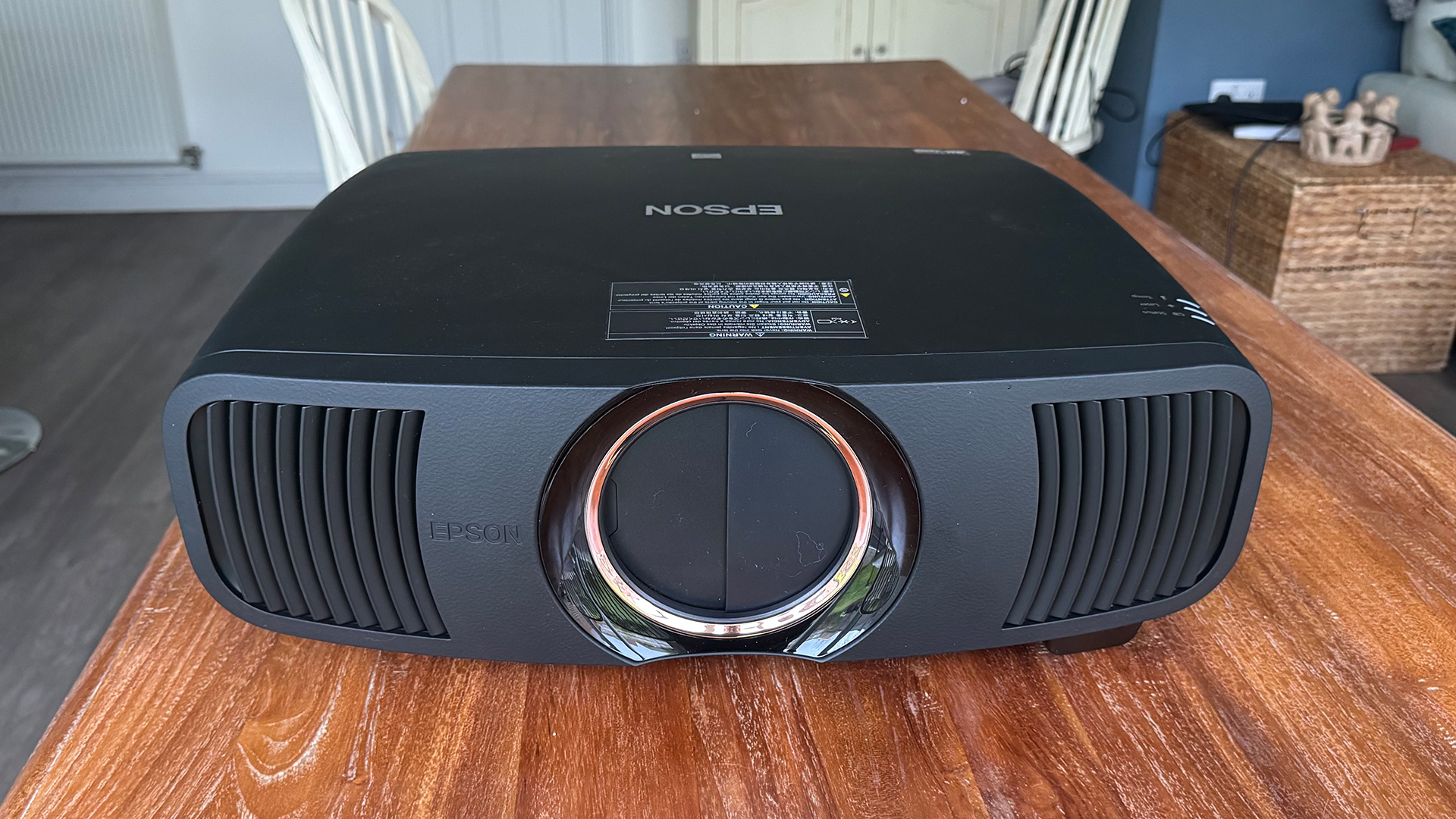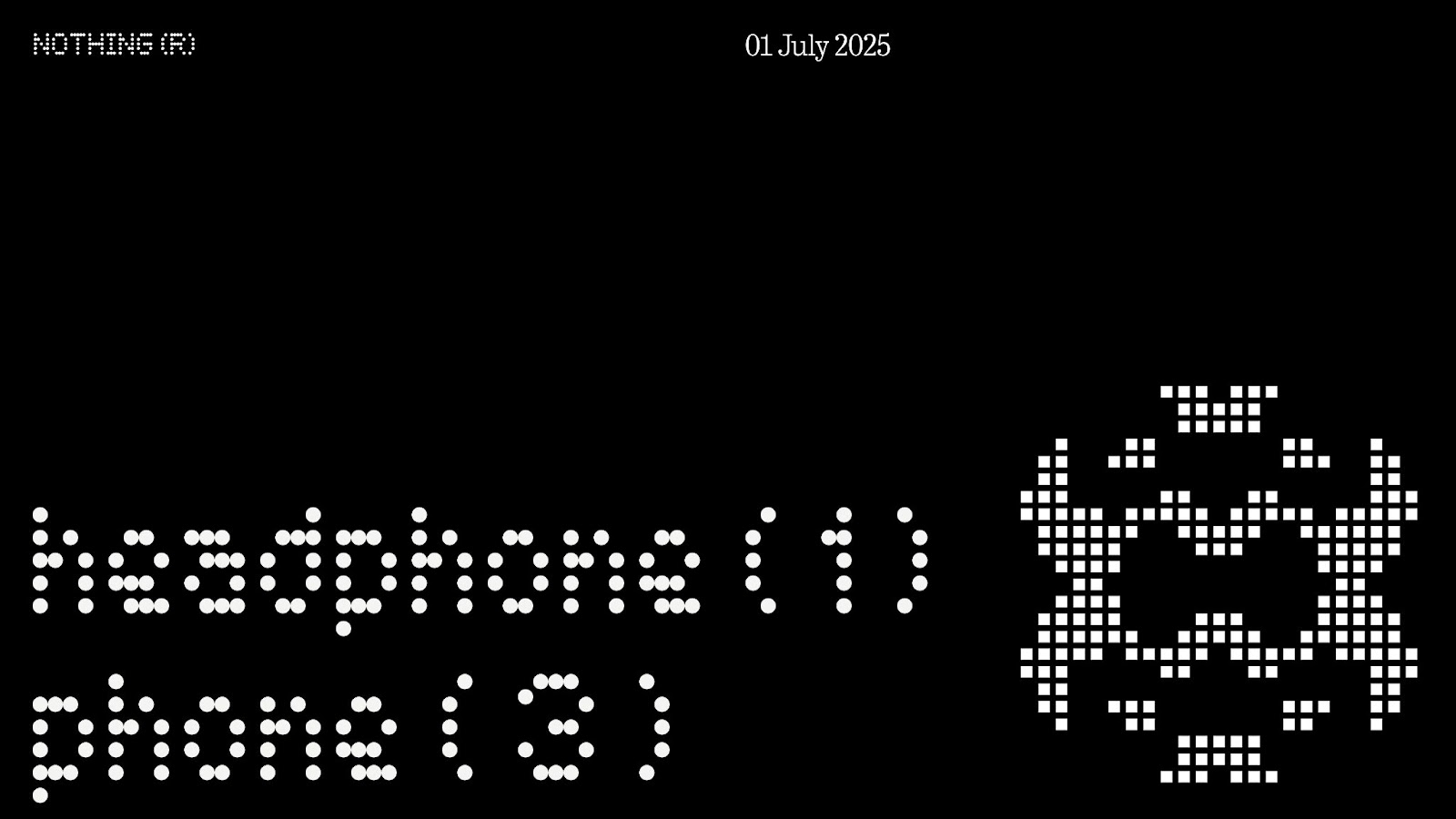What Hi-Fi? Verdict
Epson’s latest ‘proper’ home cinema centrepiece brilliantly spares more than a thought for gamers without compromising its big movie-loving heart
Pros
- +
Bright, colourful, HDR pictures
- +
Excellent gaming support
- +
Massive suite of fine-tuning options
Cons
- -
Dark areas can look slightly grey
- -
No built-in smart features
- -
Doesn’t support 3D
Why you can trust What Hi-Fi?
Epson’s projector division has been very busy in recent months. In that time it has served up a giddy mix of ultra short throw and ‘lifestyle’ coffee table projectors, but one thing has been conspicuously absent amid all the froth and fun: a new, serious home theatre projector. Happily, that changes here with the arrival of the EH-QB1000.
Everything from this new projector’s substantial design to its eye-catching spec sheet screams that here we have a new Epson projector that’s aimed squarely at proper home cinema fans. Um, except that on closer inspection, it isn’t actually only aimed squarely at proper home cinema fans. Tucked into its long list of premium attractions are a few that clearly show some serious love for gamers, too.
Which is all well and good, of course, given that console and PC gaming is now taken at least as seriously as watching films in many AV fans’ homes. Provided that the QB1000’s new-found love of gaming hasn’t caused Epson to take its eyes off the ball when it comes to its bread and butter business of making Hollywood look good, that is.
Price
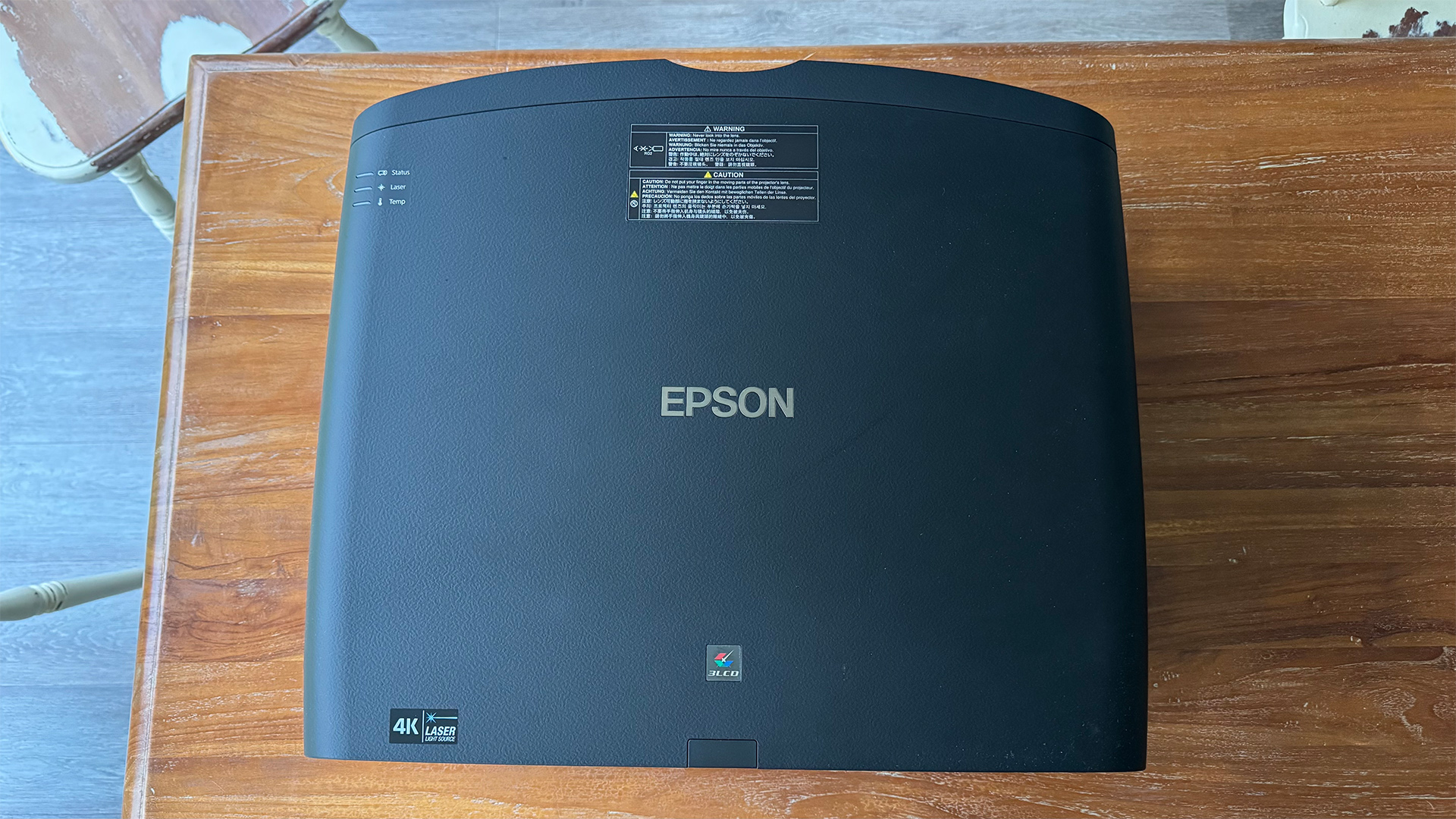
The EH-QB1000, which is available in black (EH-QB1000B) or white (EH-QB1000W) is positioned in Epson’s range as a premium home cinema projector best used in a dedicated home cinema room. It’s no surprise, then, to find it costing a fair bit more (£4799 / $7999 / AU$11,900) than the relatively casual, living room-focused 4K HDR projectors that are currently all the rage.
Provided it delivers on its on-paper movie and gaming performance promise, though, that price could soon start to look very reasonable in the context of a projector market where top-flight home theatre models such as Sony’s sublime XW8100ES can cost multiple tens of thousands of pounds. In fact, looked at in this context, the QB1000 really isn’t particularly expensive at all for something that could become the heart of a dedicated entertainment room capable of putting the 'cinema' in 'home cinema'.
Design
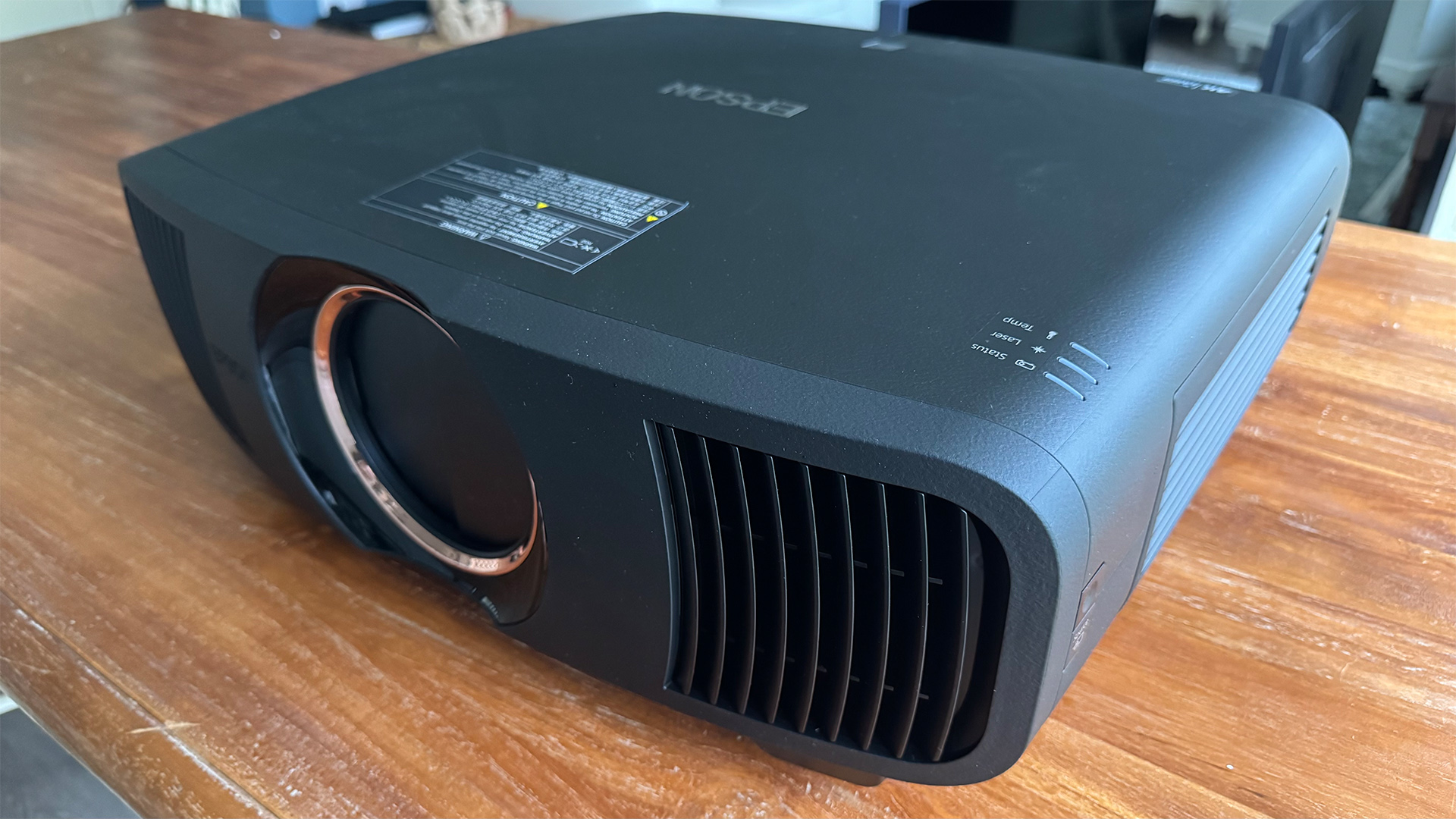
For anyone pondering using the QB1000 in a living room rather than a dedicated home cinema room, you need to know that it’s big. As in, really big. Bigger, in fact, than even most of the high-end megabucks projectors we occasionally get to strain our test benches with. It’s also pretty heavy, and the black finish of our sample and the presence of all sorts of dramatic-looking venting on its front and side edges complete the impression that the QB1000 really isn’t here to mess about.
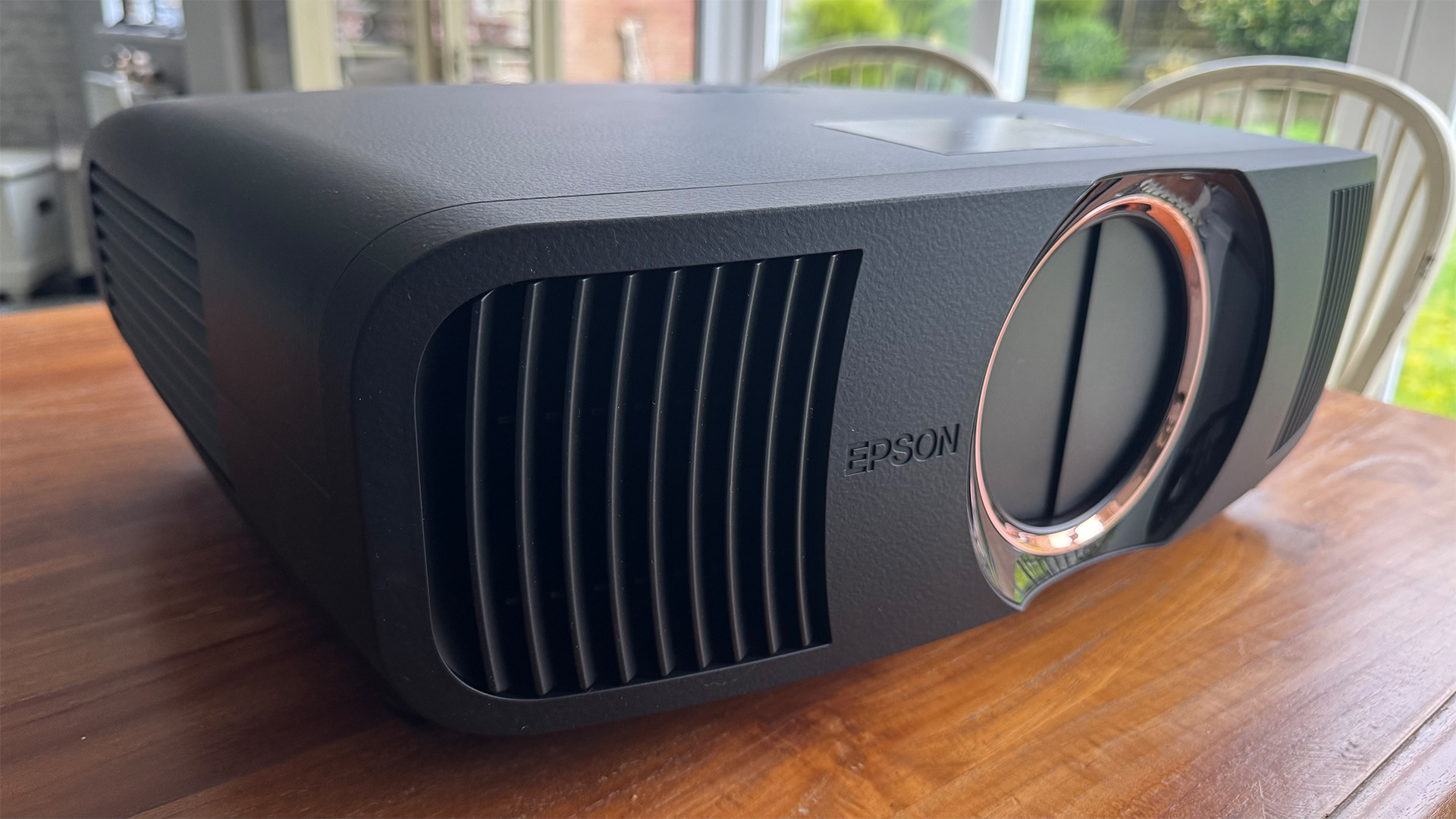
Projector type Laser-lit LCD
Screen size 50 to 300 inches (claimed)
Native resolution 4K (via pixel shifting)
Input lag 19ms (60Hz)
HDR support HLG, HDR10, HDR10+
Dimensions 19 x 52 x 45cm
Weight 12.8kg
That’s not to say there’s no fun to be found around its epic form, though. The recessed lens sports an opulent-looking gold metallic ring around its edge, for instance, and every edge and corner is gently and gradually rounded off to try and soften the ‘I’m dead serious, I am’ vibe.
Despite being the polar opposite of portable, the QB1000’s lens features a dust and damage-preventing shutter system that automatically opens when the projector’s turned on and closes when it’s on standby.
The QB1000 supports ceiling installation as well as table-top placement, of course, as you would expect of a relatively premium projector targeted at dedicated cinema room environments. Though if you’re thinking the presence of all the vents scattered around the QB1000’s bodywork might point to levels of heat and fan noise emerging from it that would make ceiling installation all but essential, we’re happy to say that its physical presence when running isn’t nearly as disruptive as you might expect of such a bright projector, even if you find yourself sat quite close to it.
Features
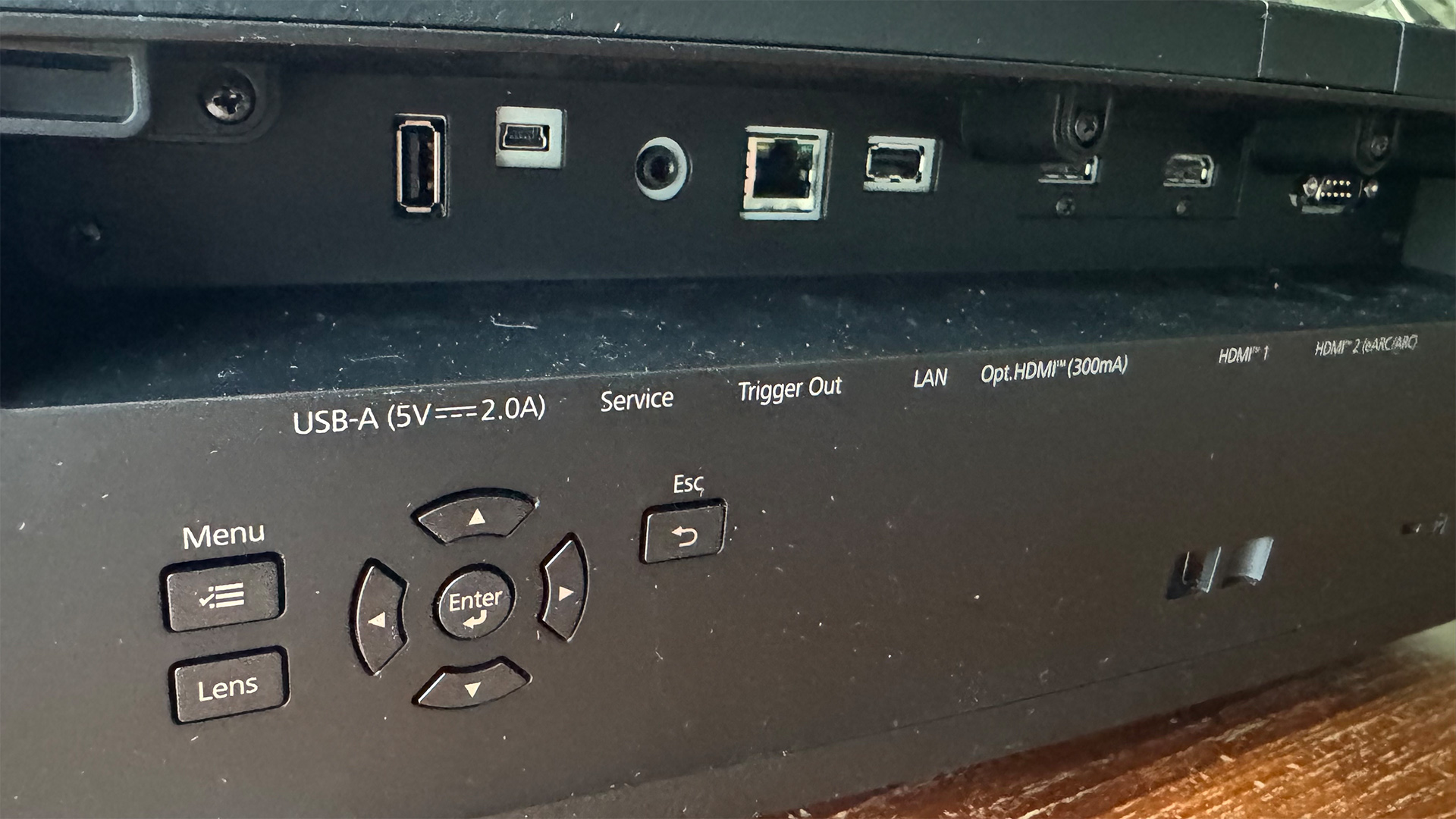
The QB1000 talks a good talk when it comes to justifying its home cinema claims and step-up price point. For starters, it uses a laser lighting system to illuminate a three-chip LCD optical system that’s claimed to muster a peak light output of 3300 lumens. While we see brightness figures like that fairly routinely now on some living room and ultra short throw projectors due to them often needing to punch through ambient light, it’s an unusually high figure for a serious home cinema projector that’s intended to be used in a blacked-out room. BenQ’s excellent W5800 rival, for instance, tops out at 2600 lumens.
Going for so much light in a home cinema environment clearly indicates that the QB1000 is serious about trying to make something of the high dynamic range technology today’s premium picture sources are so often mastered in. HDR is notoriously difficult for projectors to handle convincingly, given that it was originally designed for much brighter TVs, but 3300 lumens in a darkened room should certainly go further than most movie projectors can in delivering a good sense of HDR’s expanded light range.
This much brightness with a dark room projector, though, can make it difficult to deliver dark movie scenes convincingly. Projectors do not, after all, (currently) have the sort of local light controls that most TVs do. Epson confidently claims, however, that the QB1000 can deliver a dynamic contrast ratio of 5,000,000:1 – a huge figure that raises dreams of the sort of perfect black colours you might get from an OLED TV. Crikey.
The word ‘dynamic’ is doing a lot of heavy lifting in the QB1000’s contrast ratio claims, though, indicating as it does that the monster contrast ratio figure depends on the projector adjusting its light output in real-time to adapt to the image content being shown, with the extremes of light the projector can achieve in this way being used to calculate the claimed contrast ratio. In other words, you will never see anything even close to that sort of contrast while watching real-world content.
Nonetheless, unrealistic as it is, a 5,000,000:1 contrast claim at least raises hopes that despite its high brightness this is a projector that still understands the importance of credible blacks to movie picture quality.
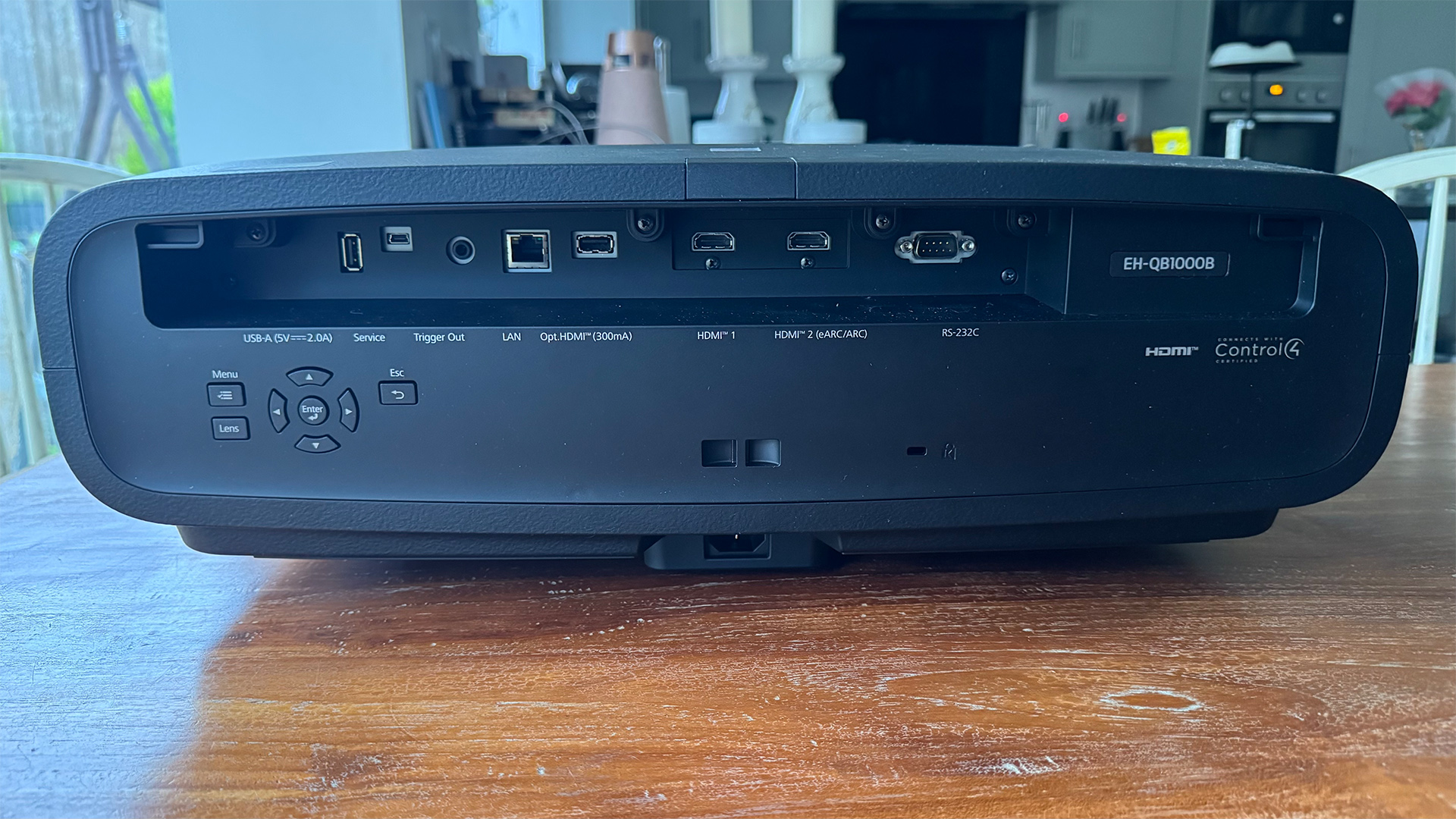
Some will argue that the Epson QB1000’s claims to be a 4K projector are also questionable. It is true, after all, that its LCD chips do not carry true 3840x2160 pixel counts, meaning that a pixel shifting system needs to be used to create an effective sense of 4K pixel density when the projector is playing a 4K source – rather than you getting a true pixel-for-pixel representation of the incoming picture. As we’ll see, though, if the QB1000 isn’t a true 4K projector in the way that Sony’s 4K SXRD projectors are, it does a pretty good impression of it.
Epson claims the QB1000 is bright enough to sustain a 300-inch image if you have a room big enough to handle that. Our advice would be that you don’t push things that far, and instead use the extra punch available at smaller screen sizes to get more value out of its ability to play high dynamic range images in not just the basic HDR10 and HLG formats, but also the premium HDR10+ one, which adds extra scene by scene picture information to deliver more accurate and dynamic results.
The QB1000 also carries a built-in dynamic tone mapping system it can use to ‘translate’ basic HDR10 sources to the full extent of its optical capabilities. We’ve found such systems to generally be invaluable in helping projectors work well with HDR content, so it’s great to find Epson adding one to the QB1000.
If you prefer a more hands-on, DIY approach to image set-up, the QB1000 also caters for full calibration with one of the most extensive sets of picture fine-tuning aids we’ve seen on a projector. These include an unusually credible frame interpolation system and full white balance and colour management.
The good news continues to roll in with the QB1000’s connections, as it turns out that its two HDMI ports are capable of handling 120Hz frame rates – even at 4K resolutions. This makes it a potentially fantastic option for owners of the Xbox Series X, PlayStation 5 or a powerful PC who want to enjoy the extra responsiveness and fluidity that 4K/120Hz gaming makes possible. The projector also achieves an outstandingly low input lag measurement of 19ms in its Game mode – a mode it can automatically select when a game source is detected courtesy of its support for ALLM.
When it comes to setting the QB1000 up so that it’s delivering its pictures in the right position and proportions for your screen, it again delivers a premium experience courtesy of motorised zoom, shift and focus adjustments. The zoom range is an impressive 2.1x, while the image shifting can be done horizontally as well as vertically and is fully optical, meaning you don’t have to worry about digital processing distorting the picture.
No less than 10 different lens setting memory slots are provided, too, to make it easier for people with 2.35:1 aspect ratio screens to handle different source aspect ratios. And if you’re looking to make the QB1000 part of a wider integrated home entertainment system, it supports full IP control with Crestron, Control4 and wired LAN connectivity.
There are a couple of tricks even the feature-rich QB1000 doesn’t provide, though: 3D playback, and any sort of smart system. While the lack of 3D (which the BenQ W5800 does support) will upset the format’s passionate fans, though, it seems as if the number of such fans is dwindling as fast as the amount of new 3D content for them to consume. As for the lack of built-in streaming services, such systems in projectors are currently typically pretty ropey in terms of both the services they provide and the quality of the streams they can play. So it makes much more sense for a relatively premium, performance-focused projector such as the QB1000 to be partnered with a higher-quality external streaming source such as the Apple TV 4K.
Picture
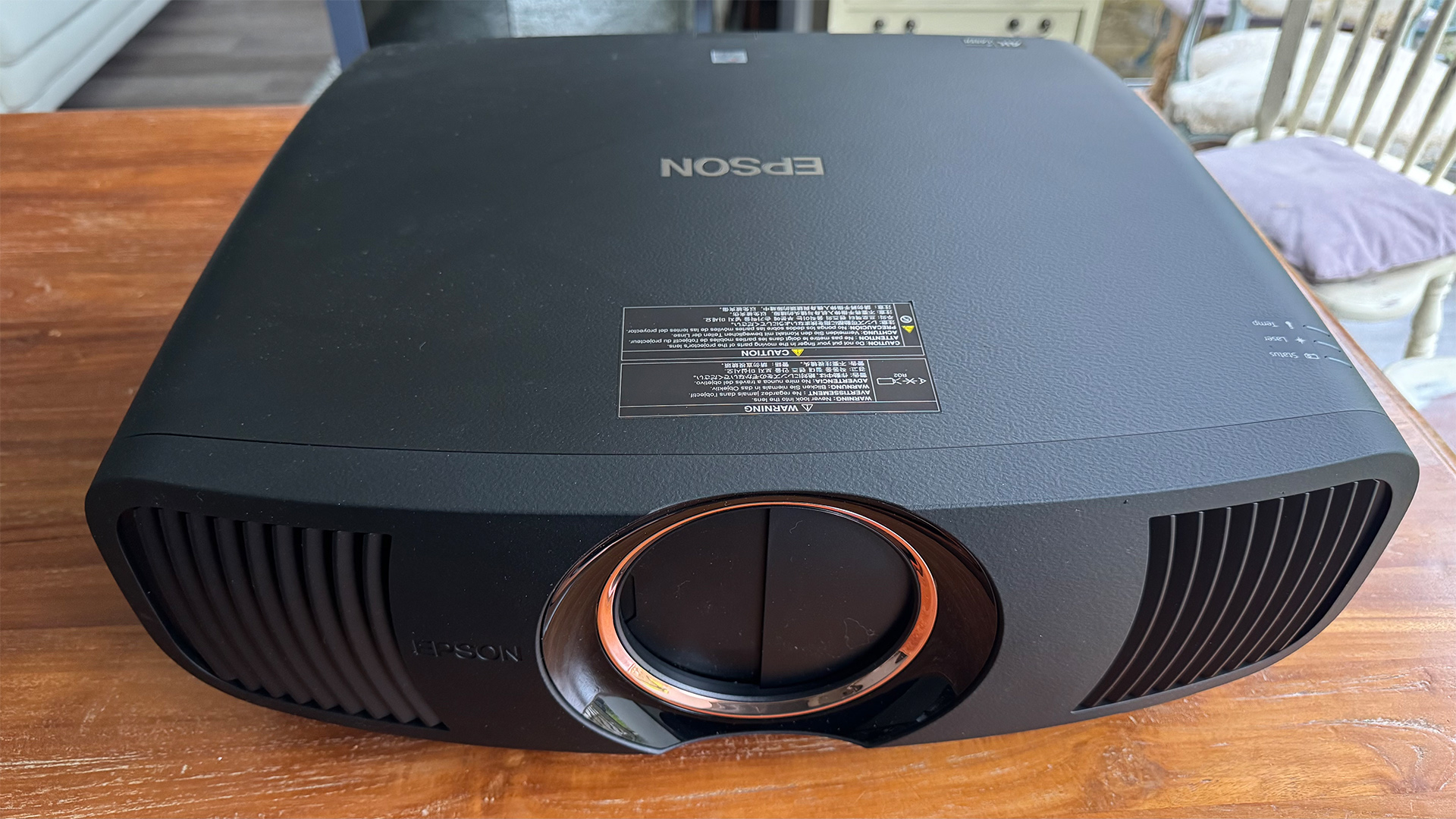
The Epson QB1000’s images come out all guns blazing and don’t ever really let up. Which is absolutely fine by us.
As hoped from the claimed 3300 peak light output, the QB1000 manages to imbue HDR images with way more brightness than most projectors manage. As well as selling the life-like benefits of HDR more successfully than the vast majority of projectors we’ve tested, this brightness also feeds into an exhilarating colour performance that manages to maintain fantastic levels of vibrancy and richness even when the projector seems to be running right up to the edge of its light range. The desaturation effect that can occur when projectors or TVs don’t have the colour capability to keep up with their brightness extremes is not an issue here.
Somehow, the QB1000 is able to deliver its excellent colour potency without having to call in the sort of brightness-dimming colour filter we’d usually expect to see accompanying such a wide gamut. So you really can experience both the brightness and wide colour range aspects of a true HDR experience. In the ridiculously enjoyable Vivid preset, in fact, the QB1000’s colours look so intense that they sometimes make the 3300 lumens of quoted maximum brightness feel conservative.
While the QB1000’s seriously intense brightness and colour get it off to a heck of a start, these elements are of course only part of a good HDR image. Also key is the ability to combine the bright, colourful stuff with convincing blacks – and it’s here where so many otherwise fun projectors come a cropper. The QB1000, though, while not on a par with JVC’s remarkable (and way more expensive) D-ILA projectors in this respect, performs better than we would have expected considering a) how bright it is, and b) that it doesn’t aggressively dim bright image highlights down if they appear against a dark backdrop.
So while blacks and dark areas don’t look completely, neutrally black, the degree of greyness that sneaks into them isn’t nearly heavy enough to spoil the show of such a reasonably priced dedicated home theatre projector.
The QB1000’s conviction with dark scenes is considerably helped, too, by the way that it’s able to pull out all the faint details hiding away in the darkest corners and shadows of an HDR movie image. This ensures that dark scenes deliver essentially the same level of detail and depth as bright ones, maintaining the sort of picture consistency as a film moves between bright and dark scenes that’s essential to keeping you immersed in the action.

We are pleased to see, too, that the QB1000’s dynamic contrast feature works brilliantly. Any adjustments the projector makes to its light output to optimise brightness or black levels, based on the incoming images, happen so instantaneously after cuts or are delivered so subtly within a shot that you only feel aware of the beneficial end result, rather than being distracted by the ‘mechanics’ of what the projector is doing to achieve those results.
We suggest using the high-speed setting for the Dynamic Contrast feature as it delivers slightly better black levels than the milder Normal mode and doesn’t appear to cause the sort of light instability during dark shots that the same setting has on one or two other Epson projectors in days gone by.
Despite not being a ‘true’ 4K projector, the QB1000’s pictures look extremely sharp and clean. Pretty 4K adjacent, in fact – or, at any rate, substantially denser and smoother than regular HD would at the sort of screen sizes you’ll be watching. The Low setting of Epson’s motion processing system proves unexpectedly useful for making judder with 24p sources less potentially jarring, too, without either leaving films looking like soap operas or generating much in the way of unwanted processing side effects.
Gaming on the QB1000 proves every bit as fun as we’d hoped. The surprising responsiveness created by its 120Hz frame rate support and sub-20ms of input lag joins forces with its vibrant colours and appreciation for detail to bring game worlds to life so effectively that you never want to leave them. Especially when you’re enjoying them on the epic scale the QB1000 can produce.
The only little niggle we found with the QB1000 was that we found ourselves regularly torn between two of its picture presets. The Vivid mode is, unlike similar modes on most TVs, seriously hard to resist thanks to its combination of high brightness and, as its name suggests, fantastically fully saturated colours – just don’t forget to tone down its rather heavy-handed default motion processing setting.
The Vivid mode can occasionally, though, show a little colour striping noise where there should be subtle HDR blends, and also every now and then produces a dark area that looks a bit forced and overwrought if it’s appearing alongside a large, very bright HDR object. These problems disappear if you use the QB1000’s Cinema preset though, and you get an all-around more balanced and refined image too. That said, this setting looks less gratifyingly punchy and ‘HDR’ than the Vivid setting, and it certainly doesn’t exploit as much of the projector’s potential.
In the end, we find ourselves deciding on an almost film-by-film basis which setting we feel works best – and typically a great time is had by all no matter which way we go. But it would still be nice if it was easier to either inject a little more vibrancy into the Cinema mode (without messing its balance up) or fix the couple of Vivid mode glitches.
The QB1000 absolutely deserves, though, for us to finish the performance part of this review on a purely positive note. So let’s do just that by saying first that, since it uses LCD technology, it is immune to the colour-striping rainbow effect that can plague some DLP projectors; and second that, while the QB1000 thrives on HDR content (something that can’t be said of every or even most HDR projectors), its many picture charms also adapt expertly to the milder, more refined needs of SDR content.
Verdict
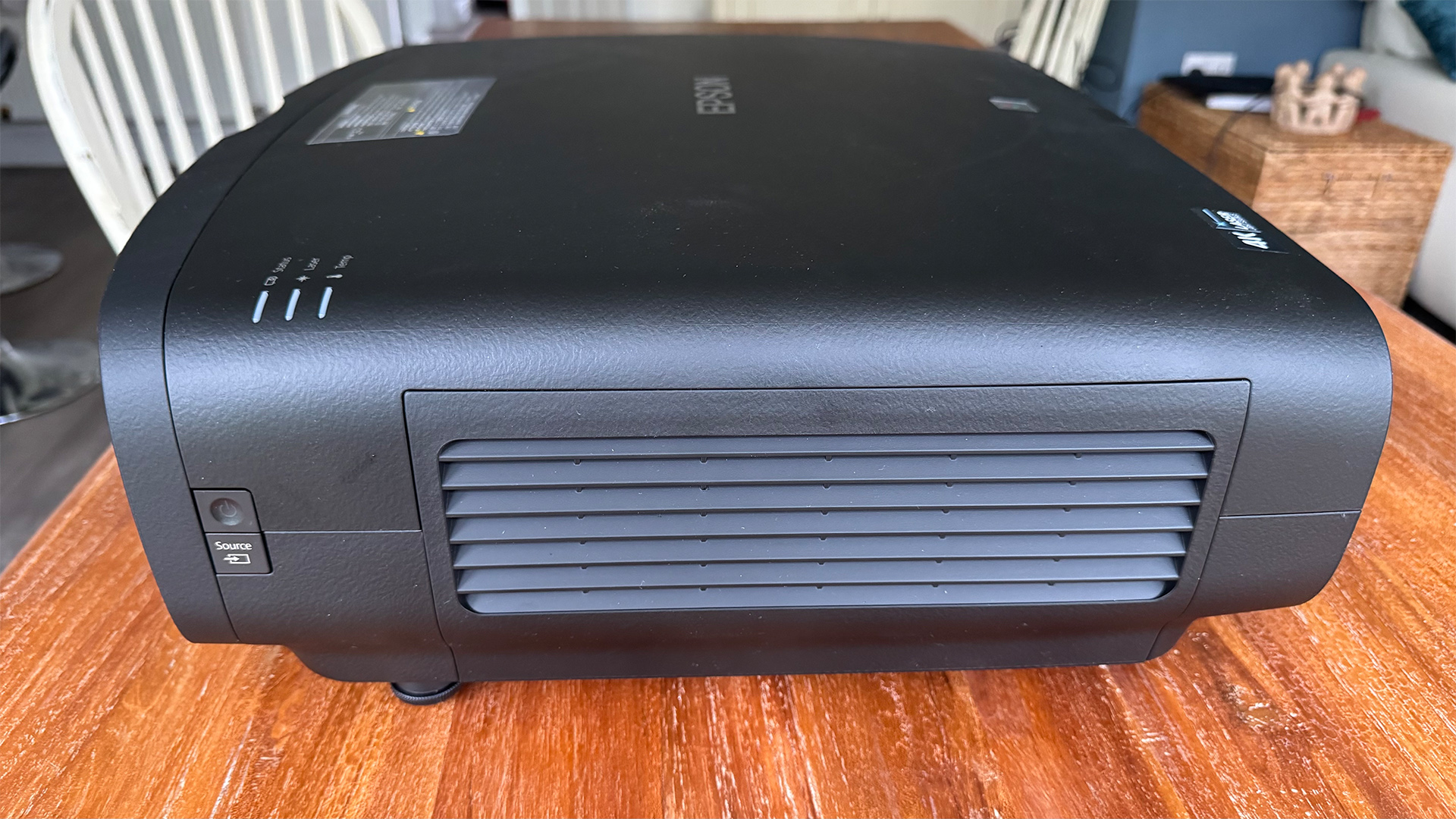
It might have taken its own sweet time to get here, but Epson’s long-awaited new ‘serious’ home cinema projector proves well and truly worth the wait. The QB1000 adds excellent gaming chops to the sort of endlessly watchable picture quality we’ve come to expect from Epson’s dedicated home cinema projectors, and basically improves in pretty much every way over its Award-winning LS12000 predecessor.
If you want a projector that can really make something of HDR without blowing a black level gasket in a dark room and without spending multiple tens of thousands of pounds, you absolutely owe it to yourself to check out the Epson QB1000.
SCORES
- Picture 5
- Design 4
- Features 5
MORE:
Read our review of the Epson EH-LS12000B
Also consider the BenQ W5800
Read our Sony VPL-XW5000ES review
John Archer has written about TVs, projectors and other AV gear for, terrifyingly, nearly 30 years. Having started out with a brief but fun stint at Amiga Action magazine and then another brief, rather less fun stint working for Hansard in the Houses Of Parliament, he finally got into writing about AV kit properly at What Video and Home Cinema Choice magazines, eventually becoming Deputy Editor at the latter, before going freelance. As a freelancer John has covered AV technology for just about every tech magazine and website going, including Forbes, T3, TechRadar and Trusted Reviews. When not testing AV gear, John can usually be found gaming far more than is healthy for a middle-aged man, or at the gym trying and failing to make up for the amount of time he spends staring at screens.
You must confirm your public display name before commenting
Please logout and then login again, you will then be prompted to enter your display name.
